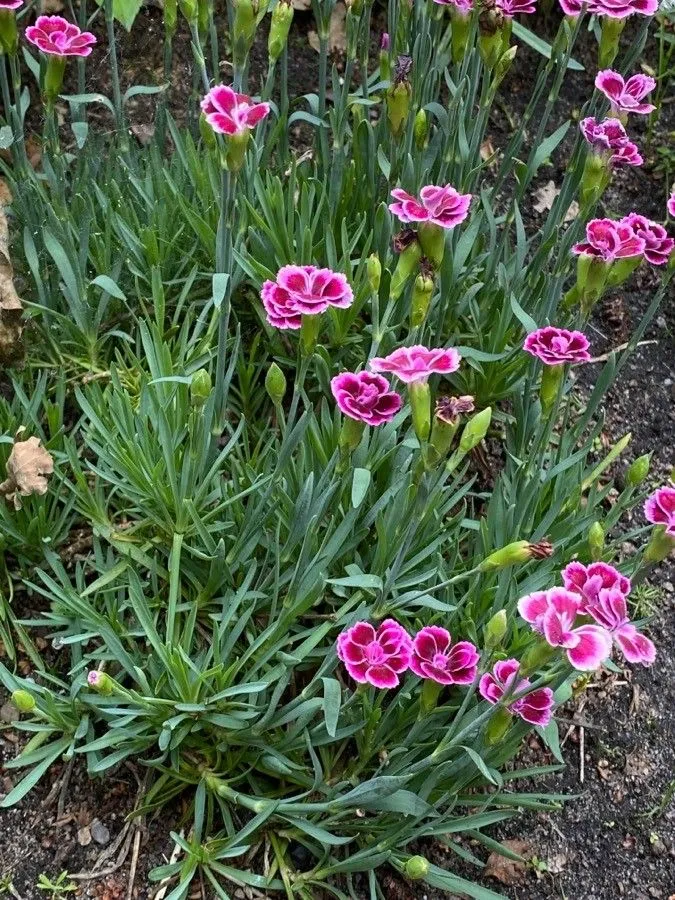
Author: L.
Bibliography: Sp. Pl.: 409 (1753)
Year: 1753
Status: accepted
Rank: species
Genus: Dianthus
Vegetable: False
Observations: European Mts., S. Russian Far East to N. Korea
Sweet-william, scientifically known as Dianthus barbatus, is a charming and aesthetically pleasing plant that belongs to the family Caryophyllaceae. Originally described in Species Plantarum in 1753 by the renowned botanist Carl Linnaeus, this plant has captivated gardeners and nature enthusiasts for centuries.
Native to the mountainous regions of Europe, the southern Russian Far East, and extending its natural habitat into northern Korea, Sweet-william thrives in a variety of landscapes. Its adaptability to different environments has contributed to its widespread cultivation in gardens around the world.
The plant is particularly admired for its vibrant and densely packed flower clusters, which make a striking addition to any floral arrangement or garden bed. The blossoms, which come in a wide range of colors including pink, white, red, and purple, often showcase intricate patterns and fringed petals that add to their ornamental appeal.
Sweet-william’s botanical characteristics include its lush, tapered leaves and robust stems that can grow anywhere from 12 to 24 inches tall. This hardy plant is a biennial, meaning it has a two-year life cycle; in the first year, it focuses on growing a strong vegetative base, while in the second year, it blooms abundantly.
Beyond its visual beauty, Dianthus barbatus also carries a mild, spicy fragrance that is often described as clove-like, adding another sensory dimension to its allure. This fragrance makes Sweet-william a favorite among pollinators like bees and butterflies, which contributes to garden biodiversity.
Cultivating Sweet-william is relatively straightforward. It prefers well-drained soil and a sunny location to thrive. Although it is quite hardy, providing the plant with regular watering and occasional fertilization can enhance its growth and floral display.
Overall, Sweet-william is a versatile and attractive addition to gardens, promising not only a splash of color but also an evocative scent that can enhance any outdoor space. Its historical and botanical significance, coupled with its aesthetic versatility, make it a beloved choice among both experienced gardeners and beginners alike.
Deu: bart-nelke
Pol: goździk brodaty
Dan: studenter-nellike
Eng: sweet-william, sweetwilliam, sweet william, bearded pink
Swe: borstnejlika, harjaneilikka
Nno: busknellik
Nob: busknellik
Spa: clavel imperial
Por: cravina-roxa
Est: habenelk
Fin: harjaneilikka
Ces: hvozdík vousatý
Fra: oeillet barbu, oeillet de poète
Lit: šiurpinis gvazdikas
Nld: duizendschoon
Cym: penigan barfog, penigau barfog
En: Sweet-William, Sweetwilliam, Sweet William, Bearded pink, Sweet William [Dianthus]
Af: Baard anglier
Be: Гваздзік барадаты
Bg: Брадат карамфил
My: Mani-saythu-pan
Ca: Clavell de pom, Clavell valencià
Zh: Tou shi zhu, 须苞石竹
Cs: Hvozdík vousatý
Da: Studenter-Nellike
Nl: Duizendschoon
Et: Habenelk
Fi: Harjaneilikka
Fr: Oeillet barbu, Oeillet de poète, Œillet de poète, Oeillet de Girardin, Œillet barbu
De: Bart-Nelke, Bartnelke
Ga: Lus na gile
It: Garofano montano
Ja: Amerika-nadeshiko
Lt: Šiurpinis gvazdikas
Nb: Busknellik
Nn: Busknellik
Fa: قرنفل
Pl: Goździk brodaty
Pt: Cravina-roxa
Qu: Sunkha klawil
Ru: Гвоздика турецкая
Sk: Klinček bradatý
Es: Clavel imperial, Clavel de poeta, Macetilla, Minutisa, Clavelina, Clavel del poeta
Sv: Borstnejlika, Harjaneilikka
Zh-tw: 鬚苞石竹
Zh-hant: 鬚苞石竹
Tr: Hüsnüyusuf
Uk: Гвоздики бородаті
Vi: Cẩm chướng thơm lùn
Wa: Bouket-tot-fwait
Cy: Penigan barfog, Penigau Barfog
© copyright of the Board of Trustees of the Royal Botanic Gardens, Kew.
© copyright of the Board of Trustees of the Royal Botanic Gardens, Kew.
© copyright of the Board of Trustees of the Royal Botanic Gardens, Kew.
Taken Jun 15, 2019 by Dieter Wagner (cc-by-sa)
Taken Jun 10, 2018 by Jean-Baptiste Armengaud (cc-by-sa)
Taken Jun 15, 2019 by Dieter Wagner (cc-by-sa)
Taken Jun 15, 2019 by Dieter Wagner (cc-by-sa)
Taken Jun 15, 2019 by Dieter Wagner (cc-by-sa)
Taken May 21, 2022 by Rosie DANIEL (cc-by-sa)
Taken May 15, 2022 by Tristan Jaton-Maria (cc-by-sa)
Taken Jun 18, 2019 by Roß Tina (cc-by-sa)
Taken May 21, 2022 by Rosie DANIEL (cc-by-sa)
Taken May 21, 2022 by Rosie DANIEL (cc-by-sa)
Taken Jun 8, 2022 by Radu Nicolau (cc-by-sa)
Taken Oct 12, 2022 by Jim Knopf (cc-by-sa)
Taken Dec 29, 2013 by Tela Botanica − Pierre CROUZET (cc-by-sa)
Taken May 15, 2022 by Tristan Jaton-Maria (cc-by-sa)
Taken Jun 23, 2019 by Catherine Heald (cc-by-sa)
Taken Jun 8, 2022 by Jacques Zuber (cc-by-sa)
Taken Jul 13, 2020 by groves Sara (cc-by-sa)
Taken Jul 4, 2021 by Kleiner Prinz (cc-by-sa)
Taken Jun 19, 2020 by Alain rivière (cc-by-sa)
Taken May 30, 2022 by Daniel Dumon (cc-by-sa)
Taken Apr 30, 2019 by Ludmilla RUAUD (cc-by-sa)
Taken May 31, 2021 by Sabin Poenariu (cc-by-sa)
Taken Jul 6, 2021 by Llandrich anna (cc-by-sa)
Taken Nov 22, 2018 by Manuel Hernández (cc-by-sa)
Taken Nov 6, 2021 by Arancibia Paula (cc-by-sa)
Taken Jul 10, 2022 by Wiki Nowak (cc-by-sa)
Taken Jun 14, 2022 by Luzia Sundermeyer (cc-by-sa)
Taken Sep 29, 2019 by Walter WiggyWorm (cc-by-sa)
Taken Aug 7, 2019 by Mannig Kolja (cc-by-sa)
Taken Aug 2, 2020 by Jenn (cc-by-sa)
Growth habit: Forb/herb
Ph maximum: 5.0
Ph minimum: 4.5
Light: 8
Atmospheric humidity: 6
Bloom months: [‘jul’, ‘aug’]
Soil nutriments: 1
Family: Myrtaceae Author: (F.Muell.) K.D.Hill & L.A.S.Johnson Bibliography: Telopea 6: 402 (1995) Year: 1995 Status:…
Family: Rubiaceae Author: Pierre ex A.Froehner Bibliography: Notizbl. Bot. Gart. Berlin-Dahlem 1: 237 (1897) Year:…
Family: Sapindaceae Author: Koidz. Bibliography: J. Coll. Sci. Imp. Univ. Tokyo 32(1): 38 (1911) Year:…
Family: Asteraceae Author: A.Gray Bibliography: Pacif. Railr. Rep.: 107 (1857) Year: 1857 Status: accepted Rank:…
Family: Fabaceae Author: Medik. Bibliography: Vorles. Churpfälz. Phys.-Ökon. Ges. 2: 398 (1787) Year: 1787 Status:…
Family: Aspleniaceae Author: (Cav.) Alston Bibliography: Bull. Misc. Inform. Kew 1932: 309 (1932) Year: 1932…